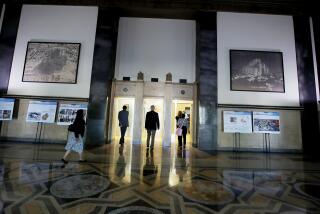Building Heals Landmark Hospital’s Growing Pains
- Share via
BARCELONA, Spain — It’s hard living inside a work of art, especially when living also means dying, giving birth, having surgery, being treated for life-threatening infections and having your bone marrow replaced.
For a century, the Hospital de la Santa Creu i Sant Pau has been one of this city’s architectural showpieces and one of its grittiest institutions.
It’s been a relic worthy of meticulous preservation and a machine racing to keep up with the present. The tension, however, has proved too much.
One hundred years after its construction, the place of beauty and the house of healing are getting an amicable divorce.
The hospital was begun in 1902 during the high tide of art nouveau that washed over Barcelona with greater force and effect than in any other part of Europe. By the time it was finished in 1912, Santa Creu i Sant Pau was perhaps the most unusual infirmary in the world: more than two dozen art-encrusted buildings arrayed over an idealized therapeutic landscape.
In his 1992 book, “Barcelona,” historian and art critic Robert Hughes calls the hospital one of the city’s “masterpieces of modernisme,” which is the Catalan word for the art nouveau movement in design, architecture, craft, music, theater, sculpture, painting and poetry.
The hospital, whose name translates from Catalan as “Holy Cross and Saint Paul,” was designed by architect Lluis Domenech i Montaner. Although Domenech contemporary Antoni Gaudi is Barcelona’s more famous architect of modernisme, the hospital epitomizes everything the movement tried to do.
With their spectacular arches, vaults and voids, the buildings speak the structural vocabulary of the Middle Ages. But with their thousands of crafted flowers, leaves, vines, birds, amphibians and other, often whimsical embellishments, they showcase art nouveau’s love of nature, color and curvilinear form. Most of all, the final product depends on craftsmanship of astonishing virtuosity: ceramics, mosaic, sculpture, tile work, stained glass, bricklaying, stonecutting and the forging of iron.
“Access to such a craft base is now irrevocably lost to the architect,” Hughes writes. “This access is what makes Catalan modernisme look so rich and strange, for mere fantasy is never enough: Fantasy has to be made concrete.”
UNESCO, the United Nations’ educational and cultural agency, named the hospital a World Heritage Site in 1997, urging its continued preservation. (There are 730 cultural and natural places with such designation.)
The hospital’s antecedent (the “Santa Creu” of its name) was founded in Barcelona’s Gothic Quarter in 1401. The original structure, not surprisingly, had become inadequate half a millennium later. In 1896, a Catalan banker and shipping magnate living in Paris, Pau Gil, died and left much of his fortune to found a new hospital for Barcelona, provided its name honored his namesake, St. Paul.
Santa Creu i Sant Pau, the product of merger and bequest, is run by a board made up of representatives of the Barcelona and Catalonia governments and the Catholic Church. It is part of Spain’s national health system network, serving about 400,000 people in the surrounding neighborhoods, and is one of the four teaching hospitals of the Autonomous University of Barcelona. Over the years, it has notched a number of Iberian firsts, including the peninsula’s first bone marrow transplant (1976) and first heart transplant (1984).
It also has retrofitted and retro-retrofitted its enormous physical plant to accommodate a century of change in medicine.
“To create a functional hospital, it is much more difficult with this architecture,” said Joaquin Lopez-Contreras, a specialist in infectious diseases, on a recent walking tour of the facility.
Around him, the broad avenues of the therapeutic city were bustling with patients, visitors, clinicians and other hospital workers moving among the various pavilions. An occasional ambulance ferried patients from one building to another, often a distance of only a few hundred yards.
The hospital has operating rooms in five buildings: the emergency room and the trauma, pediatrics, cardiology and main surgery pavilions. Outpatient clinics are maintained at about 20 sites. In addition to the medical facilities, there are dozens of air-conditioning plants to run and maintain. Computerizing the campus has been a nightmare.
“It takes 10 people just to deliver medical records from one place to another,” Lopez-Contreras said, giving just one example of how labor-intensive things are at Sant Pau. “If you need three, we have 10. If you have 10, we need 20.”
Two years ago, after much thought, the hospital board acknowledged the venerable institution’s collision with modernity. It broke ground for a new facility, which is going up on part of the 360-acre site not occupied by Domenech’s buildings. It will be finished by 2006, finally putting under one roof the care that now takes place under many.
“Not only the student of art history, but all people can discover a new thing every day,” said Josep Sarrio, one of the hospital administrators.
Domenech was particularly fond of ceramic tile. He used it in nearly hot pink to clad the vaults in the open-air portico of the administration building, the entry point onto the grounds. In the patient pavilions, the colors are only a little less daring.
In what’s now the emergency room, oceanic shades of blue and green arch overhead. The hematology pavilion has a placid milky green. In the obstetrical pavilion, yellow predominates. These are not the control-the-inmates shades common to American hospitals (and schools and prisons). They energize and soothe--up to a point.
“I’m glad the baby was born here, because the hospital is so beautiful,” said Yolanda Alquezar, a 31-year-old first-time mother, as she lay next to 3-day-old Gonzalo. She said she noticed the yellow-tiled dome overhead during delivery.
Did the view make the process less painful?
“No, the epidural did.”
A lot will change with the new hospital, but Domenech’s buildings won’t. Not a single one will be torn down. They’ll be used for research, for education, for something.
This is no surprise, as Santa Creu i Sant Pau believes in preserving the past in a way few institutions can match. Its voluminous archives contain ledgers from the 1400s that record the names of orphans brought to the hospital to live. Pressed between the pages are swatches of cloth from dresses, religious medals and beaded bracelets kept to identify individual children in case, years later, someone came looking for them.
The new hospital--costing $110 million and holding 610 beds--will be a low-profile complex with four fingerlike wings extending from a central structure.
It bears no resemblance to the old buildings and pays the ultimate tribute to Domenech’s vision. When you walk through the master’s 100-year-old entrance, you won’t be able to see it.
More to Read
The biggest entertainment stories
Get our big stories about Hollywood, film, television, music, arts, culture and more right in your inbox as soon as they publish.
You may occasionally receive promotional content from the Los Angeles Times.










